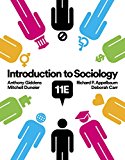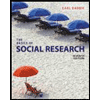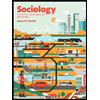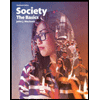
Sociology
13th Edition
ISBN: 9781259912436
Author: Schaefer, Richard T.
Publisher: Mcgraw-hill Education,
expand_more
expand_more
format_list_bulleted
Question
Chapter 7, Problem 3TIWY
Summary Introduction
To discuss: Whether the government has the right to limit the manufacturers in selling the type of weapons.
The set of laws or policies that regulates the manufacturing, selling, transfer, modification, possession or utilization of firearms by the civilians is known as gun control.
Expert Solution & Answer
Want to see the full answer?
Check out a sample textbook solution
Students have asked these similar questions
Some products are so common and in-demand that they seem to be available almost everywhere — gas stations, grocery stores, convenience shops, you name it. These kinds of items usually follow what’s called an intensive distribution strategy — the idea being that no one should have to go far to find them.
Think about products that fit this approach. What kinds of items really need to be available everywhere to be successful? What makes them a good fit for this kind of strategy?
Also, consider a specific product that always seems to be on hand wherever shopping happens — something people don’t want to go out of their way to find. How does that constant availability shape how people feel about the brand? Does it build loyalty, or is it more about convenience?
Some people see art as a reflection of reality — like a mirror that shows something true about human nature. Others think art goes deeper, not just reflecting the world but helping us make sense of it or even transform how we see ourselves. Philosophers like Plato and Aristotle had one way of thinking about this, while others like Nietzsche and Heidegger saw art as something more emotional or revealing.
Think of a piece of art — maybe a movie, book, song, or painting — that really resonated. Did it feel like it captured something real or universal about life? Or did it challenge old ideas and open up something new or unexpected?
It’s also interesting to think about how art connects to truth. Does it just imitate what already exists, or can it reveal things that logic and science can’t? Does it bring comfort or help process emotion, like Aristotle’s idea of catharsis? Or does it shake things up, like in more postmodern or philosophical ways of thinking?
Start by identifying a belief that feels true — something that seems reliable or meaningful in everyday life. Then consider what kind of reasoning or experience supports that belief.
If the belief is grounded in observation or sensory experience (like being awake), it may relate to empiricism or the correspondence theory of truth. If the belief fits within a structured system, such as mathematics or logic, Cartesian rationalism or the coherence theory might offer support. For beliefs that aren’t easily proven through evidence or logic, perspectives like deconstruction, pragmatism, or the Ewe Creativity approach may offer insight.
Consider how this belief connects to one or more of these ideas about truth, and how that connection helps clarify why the belief makes sense.
Chapter 7 Solutions
Sociology
Ch. 7.1 - Prob. 1LDCh. 7.1 - Prob. 2LDCh. 7.3 - Prob. 1LDCh. 7.3 - Prob. 2LDCh. 7.4 - Prob. 1LDCh. 7.4 - Prob. 2LDCh. 7 - Prob. 1TCCh. 7 - Prob. 1UYSICh. 7 - Prob. 2TCCh. 7 - Prob. 3TC
Ch. 7 - Prob. 4TCCh. 7 - Prob. 5TCCh. 7 - Prob. 2UYSICh. 7 - Prob. 3UYSICh. 7 - Prob. 6TCCh. 7 - Prob. 1TIWYCh. 7 - Prob. 2TIWYCh. 7 - Prob. 3TIWYCh. 7 - Prob. 1TSWYCh. 7 - Prob. 2TSWYCh. 7 - Prob. 1SQCh. 7 - Prob. 2SQCh. 7 - Prob. 3SQCh. 7 - Prob. 4SQCh. 7 - Prob. 5SQCh. 7 - Prob. 6SQCh. 7 - Prob. 7SQCh. 7 - Prob. 8SQCh. 7 - Prob. 9SQCh. 7 - Prob. 10SQCh. 7 - Prob. 11SQCh. 7 - Prob. 12SQCh. 7 - Prob. 13SQCh. 7 - Prob. 14SQCh. 7 - Prob. 15SQCh. 7 - Prob. 16SQCh. 7 - Prob. 17SQCh. 7 - Prob. 18SQCh. 7 - Prob. 19SQCh. 7 - Prob. 20SQ
Knowledge Booster
Similar questions
- I’ve been thinking about how different philosophers view the idea of the “self.” Between Plato and Aristotle, are there any beliefs about the self that you personally connect with or disagree with? How do their views compare to your own experience or perspective on identity? Some things to consider might be: Do you think we’re born with a set “essence” that shapes who we are (like the avocado view), or are we more shaped by our experiences, environment, and choices (like the artichoke view)? Or do you lean more toward the idea that there’s no fixed or separate self at all, like some non-Western philosophies suggest? How much do you think things like race, gender, class, or sexuality influence who we are? Do you believe gender identity is biologically fixed, or something more fluid and shaped by individual experience?arrow_forwardSeveral movies and television shows have portrayed individuals with special needs. Watch and review one of these films or television shows. Based on your readings and coursework, do you think the portrayals are accurate? Why or why not? What other reflections do you have after watching the movie/show? Suggested films/shows: Tim Of Mice and Men Nell Forrest Gump The Other Sister Memory Keeper’s Daughter The Good Doctor (show) The Theory of Everything Temple Grandin Peanut Butter Falcon Atypical CODA The Elephant Man Finding Nemo I Am Sam Rain Man You are not limited to these options! Feel free to choose another movie/show with characters with special needs that may be of interest to you. - Include a short summary of the movie/show, a description of the character with special needs, and your reflections from watching the movie/show.arrow_forwardwhat are some concepts from the video: Understand blockchain in under 7 minutes: Don Tapscott with Lloyds Bank https://www.youtube.com/watch?v=isuAPyuqS7Y and how does it impact the future from a societal perspectivearrow_forward
- How to explain to a school system that you live in your current address when they are accusing you of living elsewhere and when proof of residency has already been submitted?arrow_forwardHow to explain to a school system that you live in your current address when they are accusing you of living elsewhere?arrow_forwardIn the video: "How Schools Kill Creativity" https://www.ted.com/talks/sir_ken_robinson_do_schools_kill_creativity What are 2 ideas that Ken Robinson mentioned that can impact the future of educationarrow_forward
- Step 1: Find 2 news articles about a topic with opposing viewpoints that is of interest to you. You will provide the links in your submission. Step 2: Provide an article (link or copy paste) into ChatGPT, Perplexity Al, or other generative Al platform, and ask it to analyze the article using Burke's Pentad. You can ask it to use the questions below. What are some notable language choices? What is said about the agent (who did it, what kind of person are they)? What is said about agency (by what means or with what instrument was it done)? • How is the act described (what was done)? • • • • Is there any mention of the scene (where/when/what was happening during this time)? What is being implied or stated as the purpose (why was it done)? Considering the choices regarding language, agent, agency, act, and scene, what does the article/report seem to suggest caused or motivated the act? Optional: Do you see a particular ratio being advanced? Step 3: Repeat the process for a second article…arrow_forwardPhilosophical inquiry often raises questions about what it means to truly understand something. One important concept in this area is dialectic, a method of dialogue that encourages deep thinking and challenges assumptions. This is especially clear in Socratic conversations, which tend to stand out from ordinary talk because they focus less on winning an argument and more on uncovering the truth. The Socratic Method often centers on everyday beliefs—things people assume without questioning—and works by asking probing questions that reveal contradictions or gaps in understanding. In works like Meno and The Republic, the difference between knowledge and opinion becomes a central theme, especially in how Socrates guides others to realize what they do or don’t actually know. This also ties into a bigger question: is it even possible to know anything for certain? Can people ever reach perfect wisdom, especially when it comes to big, abstract ideas like justice, virtue, or truth? Some…arrow_forwardHow do the philosophical differences between conservatives and liberals influence policy debates on healthcare, education, and welfare?arrow_forward
- What are the constitutional foundations and competing philosophies of economic and social policy?arrow_forwardIs the Constitution’s flexibility a strength in our current polarized environment, or is it starting to create more gridlock than progress?arrow_forwardAfter watching a 15 minute clip by educational YouTuber CGP Grey describing how agriculture, industry and information have changed due to automation, Indicate 3 ways this video could change someones perspective on the future https://www.youtube.com/watch?v=7Pq-S557XQU&t=1sarrow_forward
arrow_back_ios
SEE MORE QUESTIONS
arrow_forward_ios
Recommended textbooks for you
 Social Psychology (10th Edition)SociologyISBN:9780134641287Author:Elliot Aronson, Timothy D. Wilson, Robin M. Akert, Samuel R. SommersPublisher:Pearson College Div
Social Psychology (10th Edition)SociologyISBN:9780134641287Author:Elliot Aronson, Timothy D. Wilson, Robin M. Akert, Samuel R. SommersPublisher:Pearson College Div Introduction to Sociology (Eleventh Edition)SociologyISBN:9780393639407Author:Deborah Carr, Anthony Giddens, Mitchell Duneier, Richard P. AppelbaumPublisher:W. W. Norton & Company
Introduction to Sociology (Eleventh Edition)SociologyISBN:9780393639407Author:Deborah Carr, Anthony Giddens, Mitchell Duneier, Richard P. AppelbaumPublisher:W. W. Norton & Company The Basics of Social Research (MindTap Course Lis...SociologyISBN:9781305503076Author:Earl R. BabbiePublisher:Cengage Learning
The Basics of Social Research (MindTap Course Lis...SociologyISBN:9781305503076Author:Earl R. BabbiePublisher:Cengage Learning Criminalistics: An Introduction to Forensic Scien...SociologyISBN:9780134477596Author:Saferstein, RichardPublisher:PEARSON
Criminalistics: An Introduction to Forensic Scien...SociologyISBN:9780134477596Author:Saferstein, RichardPublisher:PEARSON Sociology: A Down-to-Earth Approach (13th Edition)SociologyISBN:9780134205571Author:James M. HenslinPublisher:PEARSON
Sociology: A Down-to-Earth Approach (13th Edition)SociologyISBN:9780134205571Author:James M. HenslinPublisher:PEARSON Society: The Basics (14th Edition)SociologyISBN:9780134206325Author:John J. MacionisPublisher:PEARSON
Society: The Basics (14th Edition)SociologyISBN:9780134206325Author:John J. MacionisPublisher:PEARSON

Social Psychology (10th Edition)
Sociology
ISBN:9780134641287
Author:Elliot Aronson, Timothy D. Wilson, Robin M. Akert, Samuel R. Sommers
Publisher:Pearson College Div

Introduction to Sociology (Eleventh Edition)
Sociology
ISBN:9780393639407
Author:Deborah Carr, Anthony Giddens, Mitchell Duneier, Richard P. Appelbaum
Publisher:W. W. Norton & Company

The Basics of Social Research (MindTap Course Lis...
Sociology
ISBN:9781305503076
Author:Earl R. Babbie
Publisher:Cengage Learning

Criminalistics: An Introduction to Forensic Scien...
Sociology
ISBN:9780134477596
Author:Saferstein, Richard
Publisher:PEARSON

Sociology: A Down-to-Earth Approach (13th Edition)
Sociology
ISBN:9780134205571
Author:James M. Henslin
Publisher:PEARSON

Society: The Basics (14th Edition)
Sociology
ISBN:9780134206325
Author:John J. Macionis
Publisher:PEARSON